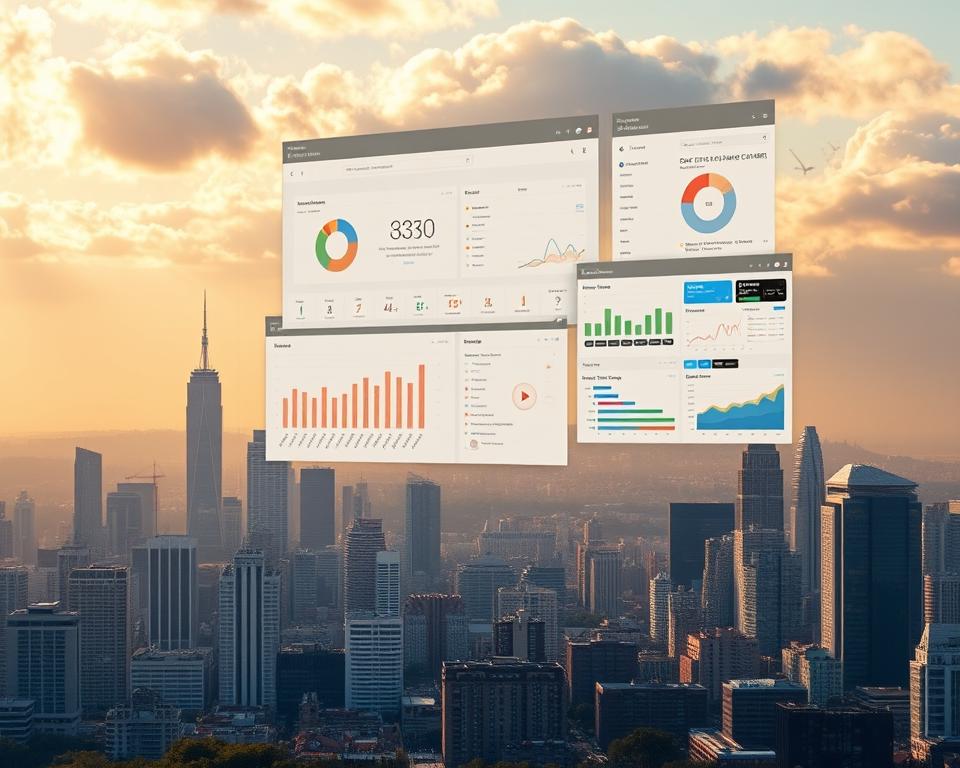Marketing1on1: Local SEO Experts – Grow Your Business
Were you aware 78% of mobile users attend a business in just one day following its discovery via regional search outcomes? Such is the might of mastering neighborhood searches—precisely what Marketing1on1 assists companies in accomplishing.
Marketing1on1 is a top-rated agency dedicated to amplifying exposure on Google Search and Maps. Their methods secure that companies emerge when consumers look for nearby services. Armed with 20+ years in the field, they assisted countless customers to flourish with personalized methods – Digital Marketing 1on1 SEO.
Google gives precedence to community-centric results, especially for “near me” queries. Marketing1on1’s proficiency guarantees your establishment distinguishes itself, attracting in-person visits and digital engagements. Their proven methods include optimizing Google My Business, managing directories, and tracking performance metrics.
Summary Highlights
- 78% of smartphone searches culminate in face-to-face visits within one day.
- Marketing1on1 concentrates on elevating search positions for enterprises.
- Google emphasizes local outcomes for service-related searches.
- 28% of local searches result in immediate purchases.
- Their dashboard integrates with major platforms for seamless management.
Understanding Local SEO and Its Importance
92% of buyers choose enterprises from the premier page—how does yours fare? Precision-targeted optimization guarantees your shop, medical center, or eatery is visible when locals inquire. Different from old-school tactics, it emphasizes nearness, Google Business Profiles, and regional directories.

Defining Hyper-Targeted Optimization
This method isolates urban or area-specific prominence. Such as, a bridal shop in Charlotte achieved a 130% increase in traffic by refining for area-specific searches. Critical contrasts with general approaches:
- Closeness: Google favors companies nearest to the user.
- References: Steady citations on Yelp or Yellow Pages establish credibility.
- Ratings: 81% of consumers check ratings before visiting.
How Local Searches Affect Your Income
Restaurants using these methods doubled foot traffic. How so? 800 million monthly local searches in America generate boundless prospects. Google ranks businesses based on:
- Relevance: The degree to which your offerings align with the query.
- Closeness: Physical location from the searcher.
- Notoriety: Online reputation and backlinks.
Voice search enhances this effect—71% favor conversational queries such as “best pizza near me.” Adjusting to these trends maintains your advantage.
The Inner Workings of Local SEO: Essential Mechanisms
Google’s system emphasizes three pivotal factors for local queries. These scoring criteria—pertinence, closeness, and visibility—decide who gets into the sought-after map cluster. Master these, and your company transforms into the preferred option for local patrons.
Understanding Google’s Local Scoring Factors
This is the method by which Google evaluates: 55% suitability, 30% closeness, and 15% visibility. Pertinence indicates how well your offerings correspond to the search. A confectionery fine-tuning for “gluten-free cupcakes” secures a superior position for that query.
Closeness is equally significant. If two businesses offer similar services, the closer one typically wins. Visibility relies on reputation—consider testimonials, references, and digital authority. An exemplary Google Business Profile boasting 100+ reviews eclipses rivals.
Contrasting Local with Conventional SEO
Precision-targeted optimization centers on map prominence and uniform NAP details. Traditional methods prioritize backlinks and broad keywords. Such as, OHSO Brewery raised traffic by 130% by refining every location’s profile independently.
- Customized Outcomes: Map results adjust within a 1-mile area.
- Mobile-Optimized: 72% of consumers access shops within a 5-mile range.
- Resources: Resources like Local Falcon trace rankings at the block level.
The Power of Google Business Profile for Local Rankings
A fully detailed Google Business Profile elevates visits by 70%—have you optimized yours? Accurate profiles receive 50% more buying interest. This no-cost tool serves as your online showcase for local patrons.
Setting Up Your Profile for Maximum Visibility
Begin by confirming your details. Google verifies your establishment’s address using mail or phone methods. Missing this step hides your profile from searches. Populate all fields:
- Classifications: Primary and secondary category picks impact 43% of rankings. Decide prudently.
- Photos: 10+ high-quality images lift conversions by 35%. Highlight merchandise, personnel, and interiors.
- Business Hours: Correct timings avert dissatisfied customers and ranking losses.
Enhancing Each Segment for Superior Outcomes
Consistent refreshes maintain your profile’s competitiveness. Organize posts with resources like Semrush Social to spotlight offers. Emulate rival keywords from service menus for pertinence.
Elements like “outdoor seating” or “free Wi-Fi” sort your company for specific searches. Link your profile to location-specific landing pages—not your homepage—for higher conversions.
Answer feedback within 48 hours. Engagement signals prominence to Google’s algorithm. An exemplary profile boasting 100+ reviews surpasses inactive rivals.
Excelling in Community Keyword Discovery
Identifying the proper keywords can determine your digital presence. For enterprises focusing on nearby audiences, keywords like near me or in [city] generate 46% of queries. Instruments such as SEMrush and Google Keyword Planner reveal these high-conversion terms.
Resources for Unearthing High-Intent Community Keywords
Initiate with competitor research. The SEMrush Keyword Gap instrument highlights weaknesses in your plan. As an example, an HVAC business observed that targeting “24-hour AC repair Phoenix” resulted in 3x higher conversion rates than broad terms.
Yelp Suggest mines hidden queries like open now Mexican restaurants downtown. Geo-grid tools like Local Falcon pinpoint underperforming areas. Voice search optimization matters too—71% of users ask for services conversationally.
Long-Tail vs. Short-Tail Keywords in Local SEO
Extended phrases (over 4 words) constitute 62% of queries. They’re specific, like best gluten-free bakery Brooklyn. Brief keywords (bakery near me) cover a broader scope yet draw less targeted traffic.
Focus on descriptors: in [city] connotes intention, while near me denotes urgency. A coffee shop targeting best latte Williamsburg saw a 35% traffic boost by refining its keyword mix.
NAP References: Cultivating Trust via Consistency
Consistent business details online build credibility—just like a well-kept storefront. Your business name, phone number, and address (NAP) should remain consistent on all platforms. Even minor discrepancies confuse customers and hurt rankings.
Premier Directories for Local Company Entries
Kick off with key directories: Google Business Profile, Apple Maps, and Yelp. Sector-specific listings (e.g., ZocDoc for medical services) enhance targeted exposure. A plumbing business achieved a 40% conversion uplift by rectifying its directory entries.
Aggregators like Data Axle spread your NAP data to smaller sites. Keep these details exact to avert broad inaccuracies. Insider tip: Work with your local Chamber of Commerce to obtain high-quality backlinks.
Identifying and Repairing Citation Inconsistencies
Employ SEMrush Listing Management to detect errors. Unify repeated listings—e.g., two Yelp profiles for one venue. Comply with these NAP standards:
- Precise match: “Ave” versus “Avenue” disturbs consistency.
- Structure: (555) 123-4567 compared to 5551234567 muddles algorithmic recognition.
- Revisions: Change your phone number? Edit every listing simultaneously.
Establish a standard guide for franchises to keep details uniform. Tools like BrightLocal track corrections in real time.
On-Page SEO Strategies for Local Businesses
Looking to attract additional local clientele? Refining your site’s internal components can transform outcomes. Companies featuring region-specific pages see a 78% improvement in rankings—indicating that subtle modifications can yield substantial gains.
Creating Engaging Title Tags and Meta Descriptions
Your title tag is like a digital storefront sign. Use this formula: “Service in City . For instance, “Emergency Plumbing in Austin .
Meta summaries ought to incorporate geographic qualifiers. “Best organic café in Portland” yields superior results compared to general phrases. Limit each to under 60 characters to prevent cutoff.
Building Conversion-Focused Location Pages
Dedicated pages for each service area boost relevance. Feature integrated maps, team biographies, and local client testimonials. A roofing company tripled leads by adding neighborhood-specific case studies.
Apply LocalBusiness schema incorporating geo-coordinates to assist search engines in showcasing your address and operating times directly in listings.
- Interlinked location strategy: Link every area page to a primary services hub.
- Mobile-first design: 53% of mobile visitors exit non-responsive websites.
- New content: Revise community guides in line with the seasons.
The Role of Online Reviews in Local SEO
93% of buyers read testimonials prior to selecting a company—what about yours? Customer feedback builds credibility, and search engines favor profiles with up-to-date, comprehensive reviews. In fact, sentiment impacts 17% of your visibility in results.
Straightforward Tactics to Prompt Positive Customer Feedback
Facilitate hassle-free review sharing. Place QR code table tents at checkout or send post-service SMS links. Marketing1on1’s streamlined methods increase review participation by 40%.
- Educate employees: A swift inquiry following a transaction drives more feedback.
- Exploit social networks: Instagram Story features directly link to review portals.
- The right timing is crucial: Ask for reviews within a day after service.
Handling Negative Reviews Like a Pro
Just one grievance might dissuade 30 prospective clients. Reply promptly using the AAA approach: Acknowledge, Apologize, Act. Take heated discussions offline with a “Let’s fix this—please email us” approach.
Tools like Semrush alert you to new feedback. One dental practice experienced a 25% boost in appointments by publicly resolving issues.
Expert tip: Highlight superior reviews on your service pages. Social proof stacks credibility and nudges visitors to contribute their own.
Earning Backlinks for Community Authority
Backlinks account for almost 30% of your exposure—are you acquiring the optimal ones? Quality backlinks indicate trustworthiness to search algorithms, elevating your company above competitors. Here’s how to earn them strategically.
Local Sponsorships and Community Backlinks
Support a youth sports team or charitable 5K event. Such collaborations typically feature backlinks on event pages. An HVAC company gained 42 authoritative links by partnering with a food bank—proof that goodwill pays off.
Target platforms like Chamber of Commerce directories. Member listings frequently include dofollow links. Expert tip: Assemble media kits for outreach to facilitate journalist features of your enterprise.
Recovering Missing Backlinks and Unattached Mentions
Use Ahrefs Content Explorer to find mentions of your business without links. Contact them courteously: “Thanks for mentioning us! Would you mind linking to our website?” This approach helped a bakery reclaim over 15 backlinks.
HARO (Help a Reporter Out) positions owners as experts. Answer inquiries with community-specific details. An HVAC specialist obtained a Forbes feature through sharing regional insights.
- Broken link building: Identify outdated collaborations of rivals. Suggest your link as a substitute.
- Data Markup: Add LocalBusiness tags to help search engines connect mentions to your profile.
- Online Discussion Platforms: Join local discussion boards (like Nextdoor) with informative input—where signatures frequently feature links.
Local Optimization for Businesses with Multiple Locations
Growing into several areas? Your website must adopt a unique method for each location. Standard tactics are insufficient—Google favors companies that individualize their digital presence for each location.
Managing Separate Profiles for Each Location
Develop individual Google Business Profiles for every business location. OHSO Brewery experienced a 130% increase in visits by refining each site’s profile separately. Essential measures:
- Unique landing pages: Showcase staff bios, local events, and neighborhood photos.
- Unified management: Use tools like Google Business Profile Manager to update hours or menus across all locations at once.
- Product tags: Highlight location-specific products (e.g., “Available at our Phoenix store”).
Sidestepping Redundant Content Traps
Duplicate service narratives damage search rankings. Instead, use city-specific content blocks. A spa chain grew organic traffic by 140% by adding neighborhood guides to each page.
For comparable pages, apply canonical tags or noindex instructions. Illustratively, “Plumbing Services in Phoenix” and “Plumbing Services in Tempe” need distinctions beyond the city title.
Voice Search and Its Impact on Local SEO
Voice search is changing how people find businesses—are you ready? Given that 71% of users favor verbal queries, tuning for natural language is essential. Phrases such as “open now” surged by 400% with voice assistants like Alexa transforming search behavior.
Refining for “Near Me” and Dialogue-Based Searches
Conversational searches employ entire questions rather than mere keywords. Instead of “best pizza,” users ask “Who has the best gluten-free pizza near me?” Customize your content to respond to these queries:
- Common Queries Sections: Address “what’s” and “where’s” questions with short responses.
- Schema markup: Use SpeakableSchema to help devices read your answers aloud.
- Featured Snippets: Aim for featured snippets—voice assistants pull answers from here.
One New York pizzeria elevated voice orders by 65% via FAQ schema adoption. Their “delivery radius” part resolved the leading voice inquiry locally.
Pro Tips for Voice Search Domination
Manage your Google Knowledge Panel. Authenticate your business data to guarantee uniformity across platforms. Optimize for Alexa and Echo by claiming your Yelp profile—these platforms prioritize it for local results.
Mobile optimization is crucial. 25% of vocal searches are conducted on mobile devices. Make sure your website is speedy and features prominent contact buttons.
Monitoring Your Community SEO Results
Are you evaluating the factors that drive your search visibility? Consistent tracking confirms that your actions yield tangible outcomes. Concentrate on indicators that show how users locate and engage with your enterprise.
Key Performance Indicators to Track
Begin by examining your map pack rank. Being among the first three results increases click-through rates by 60%. Keep an eye on “near me” rankings—as they generate quick visits.
Review velocity matters too. Profiles garnering over 5 new reviews each month accelerate growth. Employ Google Search Console to segment data by location. This shows where you’re winning or need work.
Tools for Real-Time Rank Tracking
SEMrush Position Tracking details performance on a ZIP code basis. Match it against Local Falcon’s heatmaps for precise block-by-block data. One retail outlet enhanced its CTR by 33% with this technique.
Mark Google Profile interactions with UTM parameters. This reveals which listings convert best. Monitor a minimum of three rivals—since their actions impact your rankings.
Regular reports need to be transparent and operational. Emphasize ranking shifts and correlate them with conversions. Modify your tactics in response to the observed data.
Expert Local Optimization Advice from Marketing1on1
Marketing1on1’s successful techniques advance your business exposure dramatically. Their data shows schema-optimized sites get 30% more clicks—proof that technical tweaks drive real results. These next-level strategies extend past elementary tweaks to rule search rankings throughout the year.
Utilizing Schema Markup to Enhance Local Listings
Structured data helps search engines understand your business details. The LocalBusiness markup covers cost ranges, geo-coordinates, and business hours. A landscaper using this markup dominated “spring cleanup” searches by appearing in rich snippets.
Instruments like Google’s Markup Helper streamline schema implementation. Focus on these elements:
- Service areas: Set your operational area for mobile searches
- Promotion schema: Emphasize events or periodic promotions
- Feedback structured data: Display rating stars within the search results
Seasonal Approaches to Elevate Visibility
Seasonal timing is key—88% of service searches occur on mobile during high-demand periods. Design “Back-to-School” promotions or festive specials with geo-targeted pages. Marketing1on1 advises the following Google Posts composition:
- 40% promotions (limited-time offers)
- 30% local updates (community event collaborations)
- 30% informative posts (seasonal advice)
Micro-influencers with hyperlocal followings amplify reach. A bakery collaborated with local food influencers, raising in-store visits by 25%. Ensure holiday hours are posted in advance—exclusive Google Business Profile updates mitigate customer inconvenience.
Insider tip: Build a quarterly content calendar with geo-targeted posts. Coordinate your website visuals with GBP updates to maintain a unified message.
Typical Local Optimization Pitfalls to Prevent
Minor oversights may lead to significant losses in digital exposure. Even minor oversights—like inconsistent contact details or a slow-loading website—can push potential customers toward competitors. This outlines how to dodge these frequent mistakes.
Non-Uniform NAP Data Across Listings
Your business name, address, and phone number (NAP) must match everywhere. A single typo (“Ave” vs. “Avenue”) can trigger a 37% ranking drop. For example, one restaurant experienced a 22% traffic decrease when Yelp showed an obsolete address.
- Consolidate overlapping profiles (such as dual Google My Business entries).
- Update aggregators like Data Axle to correct widespread errors.
- Audit quarterly with Yext to maintain accuracy.
Overlooking Mobile Usability in Local SEO
Over half (53%) of mobile users abandon slow-loading sites. Since 76% of nearby search happens on phones, your website needs:
- Responsive design (no pinching to zoom).
- Easy-to-access call features near the top.
- Lightweight images (less than 1MB).
Insider note: Check your mobile load times via Google’s PageSpeed Insights. A mere 1-second delay can decrease conversion rates by 7%.
Tools to Enhance and Expedite Your Local Optimization
Appropriate resources can transform digital exposure from a struggle into a strength. Be you a local enterprise or a multi-site operation, an effective toolset conserves time and magnifies outcomes. Here’s how to choose wisely.
Complimentary Tools for Small Enterprises
Begin with Google Business Profile. It serves as the cornerstone of your digital footprint. Supplement it using:
- Google’s Keyword Planner: Reveal high-intent queries like “24-hour plumber near me”.
- AnswerThePublic tool: Visualize voice search queries (e.g., “Where’s the closest ATM?”).
- Google’s Analytics: Analyze which communities yield the most visitors.
These tools require no budget but deliver actionable insights.
Robust Platforms for Expanding Operations
Bigger enterprises require powerful systems. SEMrush Local (costing $50/month for each location) delivers rank monitoring and listing administration. Compare top options:
- Yext solution: Automatically corrects listings in over 150 directories.
- Uberall: A 40-site brand conserved 300 hours per month using its unified dashboard.
- Local Falcon platform: Analyzes rankings at a granular, block-by-block level for focused optimization.
Pro tip: Merge SEMrush keyword statistics with Local Falcon’s geographical reports to gain full visibility. Platforms such as BrightLocal fill the void for mid-tier companies at $39/month.
Real-World Examples of Community SEO Triumphs
Real-world results prove the power of targeted strategies—here’s how businesses transformed their visibility. They illustrate the profit-enhancing effects of strategic adjustments.
A Dining Establishment’s Transformation from Sparse to Bustling
A Mexican restaurant in Austin saw a 112% traffic increase after optimizing its Google Business Profile and menu pages. Key tactics:
- Added geo-tagged photos of dishes like “breakfast tacos near downtown”.
- Responded to 100% of reviews within 4 hours, improving sentiment by 40%.
- Leveraged SEMrush to optimize for “happy hour specials Austin” — achieving a #1 rank in 3 weeks.
Industry Leaders Commanding Top Rankings
An HVAC firm secured page one rankings for 38 “emergency repair” search terms. Their playbook:
- Constructed localized landing pages (for instance, “AC repair in Phoenix”).
- Garnered links from community news outlets through storm readiness advice.
- Executed a “free maintenance check” campaign via Google Posts—resulting in a 30% increase in calls.
Pro tip: Marketing1on1’s law firm client gained 80 leads/month by combining local blog posts with citation cleanups. Brands operating in several locations witnessed 140% organic growth over a six-month period employing these methods.
Final Thoughts
Establishing a formidable online profile demands strategy—not rapid fixes. Marketing1on1 helps your business dominate nearby searches by optimizing Google Business Profiles, managing citations, and leveraging reviews. This sustained approach over 6–12 months transforms searches into devoted customers.
A remarkable 92% of regional searches lead to conversions within 48 hours. Reject shortcut approaches—regular tracking and quarterly audits maintain development. Start today: Claim your free audit from Marketing1on1 and refine your profile for immediate impact.
Pro tip: Monthly rank checks and fresh content keep you ahead. Command the essentials, and see your visibility escalate.


